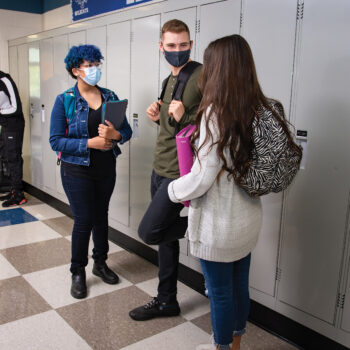Dodgeball and White Flags: Manitoba Teachers, Omicron, and In-Person Learning
Anne Bennett, Department Head, Communications and Contact Services at The Manitoba Teachers’ Society (MTS), shines the spotlight on the current situation in Manitoba and how the COVID-19 pandemic and the government’s unwillingness to be transparent, are affecting public school teachers and students.
On Monday, January 17, as Omicron raged and case numbers climbed, public school teachers in Manitoba—along with their counterparts in Quebec, Ontario, and Nova Scotia—return to in-class learning after an extended holiday break.
With the reopening, schools moved into Code Orange on the provincial pandemic response system, which requires physical distancing of two metres “to the greatest extent possible”. Medical grade masks are required for staff, although officials have stopped short of requiring N95s. Extracurricular activities are permitted, with the exception of tournaments and overnight trips.
At time of writing, Manitoba’s daily case-count continues to top 2,500 and the test positivity rate flirts with 50 percent. COVID test results are delayed and are expected to continue to be, while teachers and school staff quarantine in the coming weeks, placing additional pressure on staffing levels that were shaky even pre-pandemic.
While teachers prepare, health officials warn that further increases in COVID cases are expected, and Manitobans need only look to Saskatchewan to see what lies in wait, as outbreaks surge through our provincial neighbour’s school communities.
And what do our government officials have to say?
In a press conference January 13, Manitoba’s Education Minister Cliff Cullen and Chief Public Health Officer Dr. Brent Roussin announced a novel approach to COVID management: just live with it. Telling parents to expect a spike in cases in schools in the coming weeks, Roussin advised that the new plan is to “manage our risk, not eliminate it.”
“We have to learn to live with the virus,” echoed Premier Heather Stefanson. And by live with it, she means go back to the classroom with fingers crossed, hoping for the best—a bitter pill to swallow for Manitoba’s more than 16,000 public school teachers, readying once again to return to the front lines of COVID exposure.
Undeterred by the government’s white flag waving approach to pandemic realities, MTS has repeated its demands that the province address staffing concerns, supply appropriate PPE—including N95 masks—and address outdated ventilation systems in schools.
In response, Minister Cullen seeks to ease the minds of all by claiming that expenditures in the area of $63 million will make living with COVID easier. MTS President James Bedford is doubtful.
Bedford wants to know exactly how it is that schools unable to meet physical distancing requirements prior to the holidays are now, somehow, able to do so. What, he asks, changed between mid-December and January 17 to ensure staff and student safety.
“We’re told that despite skyrocketing case numbers, schools are safe. We’re told the government has invested a lot of money to make them safe. If that’s the case, then tell us what’s been done: How are schools to accommodate the distancing recommended? How are teachers and students less vulnerable due to outdated ventilation systems? How are teachers going to get test results back quickly enough to keep our classrooms staffed? Tell us.”
Unable to secure the answers, MTS has filed a Freedom of Information and Protection of Privacy (FIPPA) request to obtain details regarding who received funding, and where it was spent.
“I need to be clear,” Bedford says. “Teachers want to get back to the classroom. Students and families want to get back to the classroom. And MTS wants its members to get back to the classroom. That is where we know the best learning takes place. But we must make our return safely. We must settle for nothing less than complete transparency and accountability from this government.”
Across the country, all teacher associations have felt the impact of COVID-19 on their work, to say nothing of the mirror pandemic of mental health deterioration. The physical and emotional toll of continuous uncertainty has compounded, leaching the lifeblood of teachers—energy and creativity—and leaving grief and fatigue in their place. School leaders, too, are under siege, targets in a daily dodgeball game of responding to ever-changing public health orders, staff concerns and parent communication.
Other common cross-Canada themes include inconsistent direction from governments, member burnout, a lack of substitute teachers and appropriate PPE, the impossibility of consistently meeting physical distancing requirements (and as a result, managing duplex and triplex classrooms), ineffective hybrid learning models, and the wear and tear of colleague, student, and family concerns over ever-shifting public health orders.
Then there’s the cherry on top: self-doubt. That nasty, nagging voice in our members’ heads that hisses, “I’m not doing enough.”
We can’t meditate our way out of this. We just can’t.
And as Manitoba teachers and students returned to their classrooms January 17, they did so knowing their government is doing little more than crossing its fingers and hoping for the best.



